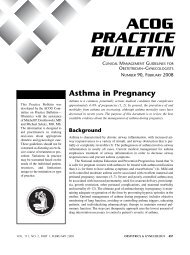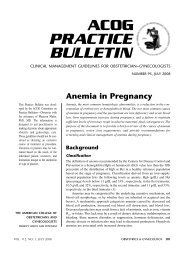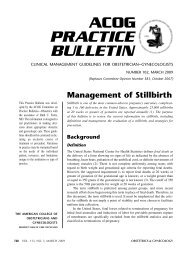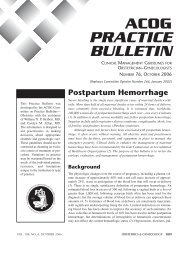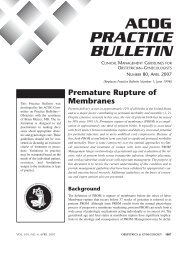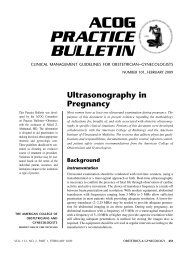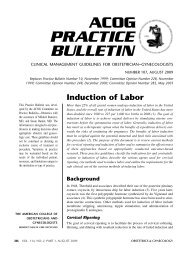ACOG Practice Bulletin: Intrapartum Fetal Heart rate Monitoring
ACOG Practice Bulletin: Intrapartum Fetal Heart rate Monitoring
ACOG Practice Bulletin: Intrapartum Fetal Heart rate Monitoring
- No tags were found...
You also want an ePaper? Increase the reach of your titles
YUMPU automatically turns print PDFs into web optimized ePapers that Google loves.
Despite the frequency of its use, limitations of EFMinclude poor interobserver and intraobserver reliability,uncertain efficacy, and a high false-positive <strong>rate</strong>.<strong>Fetal</strong> heart <strong>rate</strong> monitoring may be performed externallyor internally. Most external monitors use a Dopplerdevice with computerized logic to interpret and count theDoppler signals. Internal FHR monitoring is accomplishedwith a fetal electrode, which is a spiral wireplaced directly on the fetal scalp or other presenting part.Guidelines for Nomenclature andInterpretation of Electronic <strong>Fetal</strong><strong>Heart</strong> Rate <strong>Monitoring</strong>In 2008, the Eunice Kennedy Shriver National Instituteof Child Health and Human Development partnered withthe American College of Obstetricians and Gynecologistsand the Society for Maternal–<strong>Fetal</strong> Medicine tosponsor a workshop focused on electronic FHR monitoring(3). This 2008 workshop gathered a diverse group ofinvestigators with expertise and interest in the field toaccomplish three goals: 1) to review and update the definitionsfor FHR pattern categorization from the priorworkshop; 2) to assess existing classification systems forinterpreting specific FHR patterns and make recommendationsabout a system for use in the United States; and3) to make recommendations for research priorities forEFM. A complete clinical understanding of EFM necessitatesdiscussion of uterine contractions, baseline FHR<strong>rate</strong> and variability, presence of accelerations, periodicor episodic decelerations, and the changes in these characteristicsover time. A number of assumptions and factorscommon to FHR interpretation in the United Statesare central to the proposed system of nomenclatureand interpretation (3). Two such assumptions are of particularimportance. First, the definitions are primarilydeveloped for visual interpretation of FHR patterns, butshould be adaptable to computerized systems of interpretation.Second, the definitions should be applied tointrapartum patterns, but also are applicable to antepartumobservations.Uterine contractions are quantified as the number ofcontractions present in a 10-minute window, averagedover a 30-minute period. Contraction frequency alone isa partial assessment of uterine activity. Other factorssuch as duration, intensity, and relaxation time betweencontractions are equally important in clinical practice.Listed as follows is terminology used to describeuterine activity:Normal: five contractions or less in 10 minutes,averaged over a 30-minute windowTachysystole: more than five contractions in 10 minutes,averaged over a 30-minute windowCharacteristics of uterine contractions• The terms hyperstimulation and hypercontractilityare not defined and should be abandoned.• Tachysystole should always be qualified as to thepresence or absence of associated FHR decelerations.• The term tachysystole applies to both spontaneousand stimulated labor. The clinical response to tachysystolemay differ depending on whether contractionsare spontaneous or stimulated.Table 1 provides EFM definitions and descriptionsbased on the 2008 National Institute of Child Health andHuman Development Working Group findings. Decelerationsare defined as recurrent if they occur with at leastone half of the contractions.Classification of <strong>Fetal</strong> <strong>Heart</strong>Rate TracingsA variety of systems for EFM interpretation have beenused in the United States and worldwide (4–6). Based oncareful review of the available options, a three-tieredsystem for the categorization of FHR patterns is recommended(see box). It is important to recognize that FHRtracing patterns provide information only on the currentacid–base status of the fetus. Categorization of the FHRtracing evaluates the fetus at that point in time; tracingpatterns can and will change. An FHR tracing may moveback and forth between the categories depending on theclinical situation and management st<strong>rate</strong>gies used.Category I FHR tracings are normal. Category I FHRtracings are strongly predictive of normal fetal acid–basestatus at the time of observation. Category I FHR tracingsmay be monitored in a routine manner, and no specificaction is required.Category II FHR tracings are indeterminate. CategoryII FHR tracings are not predictive of abnormal fetalacid–base status, yet presently there is not adequate evidenceto classify these as Category I or Category III.Category II FHR tracings require evaluation and continuedsurveillance and reevaluation, taking into accountthe entire associated clinical circumstances. In some circumstances,either ancillary tests to ensure fetal wellbeingor intrauterine resuscitative measures may be usedwith Category II tracings.Category III FHR tracings are abnormal. Category IIItracings are associated with abnormal fetal acid–basestatus at the time of observation. Category III FHR tracingsrequire prompt evaluation. Depending on the clinicalsituation, efforts to expeditiously resolve theVOL. 114, NO. 1, JULY 2009 <strong>ACOG</strong> <strong>Practice</strong> <strong>Bulletin</strong> <strong>Intrapartum</strong> <strong>Fetal</strong> <strong>Heart</strong> Rate <strong>Monitoring</strong> 193



